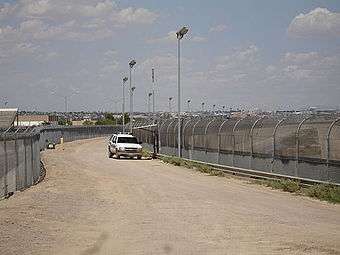Secure Fence Act of 2006
.svg.png) | |
| Long title | An Act To establish operational control over the international land and maritime borders of the United States. |
|---|---|
| Enacted by | the 109th United States Congress |
| Citations | |
| Public law | Pub.L. 109–367 |
| Statutes at Large | 120 Stat. 2638–2640 |
| Codification | |
| Acts amended | Illegal Immigration Reform and Immigrant Responsibility Act of 1996 |
| U.S.C. sections amended | 8 U.S.C. § 1103, 14 U.S.C. § 637 |
| Legislative history | |
| |

On October 26, 2006, U.S. President George W. Bush signed the Secure Fence Act of 2006 (Pub.L. 109–367) into law stating, “This bill will help protect the American people. This bill will make our borders more secure. It is an important step toward immigration reform."[1]
The bill was introduced on Sep. 13, 2006 by Peter T. King (R-NY). In the House of Representatives, the Fence Act passed 283 -138 on September 14, 2006. On September 29, 2006 – the Fence Act passed in the Senate 80 -19.
The Secure Fence Act of 2006’s goal is to help secure America’s borders to decrease illegal entry, drug trafficking, and security threats by building 700 miles (1,100 km) of physical barriers along the Mexico-United States border. Additionally, the law authorizes more vehicle barriers, checkpoints, and lighting as well as authorizes the Department of Homeland Security to increase the use of advanced technology like cameras, satellites, and unmanned aerial vehicles to reinforce infrastructure at the border.[1] Congress approved $1.2 billion in a separate homeland security spending bill to bankroll the fence, though critics say this is $4.8 billion less than what’s likely needed to get it built.
Proponents of the bill believe that it will diminish vehicle transport of illegal immigrants, encouraging those who want to enter the country to pursue legal channels or cover potentially hundreds of miles on foot and overcome a difficult obstacle. This should decrease the number of apprehensions of illegal immigrants, by physically reducing their numbers. It could also diminish the illegal drug trade pouring into the US from Mexico as well as provide additional protection from terrorist entry into the country.[2]
Opponents of the bill argue that it is not an effective strategy to curb illegal immigration because the fence is not a continuous barrier and can be climbed over or dug under in some areas. They also argue that it could harm US-Mexico relations, disrupt the environment and natural migration of wildlife, as well as increase the danger and risk of illegal immigrants attempting to cross the border. Further, opponents argue that because of the increased risk of crossing the border, illegal immigrants who previously pursued seasonal work and then returned home may have to bring their families and live permanently in the country.[2]
Since construction of the wall began “apprehensions, a rough proxy for measuring illegal crossings, were down 18% at the southern border in 2008 and Border Patrol attributes some of that to the fence. But a report in May 2009 by the Congressional Research Service found "strong indication" that illegal crossers had simply found new routes.” [3]
On January 23, 2008 the 110th Congress introduced Reinstatement of the Secure Fence Act of 2008 (H.R. 5124). This bill called for Homeland Security to construct an additional 700 miles (1,100 km) of two layered, 14 foot (4 m) high fencing along the southwest border.[4] The bill died in committee and was never voted upon.[4]
By April 2009 Homeland Security had erected about 613 miles (985 km) of new pedestrian fencing and vehicle barriers along the southwest border from California to Texas.[5]
In May 2010, Senator Jim DeMint (R-SC) unsuccessfully reintroduced his “Finish the Fence” amendment for the second time, which would require Homeland Security to construct an additional 353 miles (568 km) of fencing along the US-Mexico border.[6]
The Republican Party's 2012 platform highlighted the fact that the rest of the double fencing was never built and stated that "The double-layered fencing on the border that was enacted by Congress in 2006, but never completed, must finally be built."[7]
See also
References
- 1 2 "Fact Sheet: The Secure Fence Act of 2006". The White House. Retrieved 2010-11-01.
- 1 2 "Should the U.S. Build a Fence Across the Entire Border with Mexico to Slow Illegal Immigration". Balanced Politics. Retrieved 2010-10-29.
- ↑ Simon, Stephanie (2009-02-04). "Border-Fence Project Hits a Snag". Wall Street Journal. Retrieved 2010-10-28.
- 1 2 "H.R. 5124: Reinstatement of the Secure Fence Act of 2008". GovTrack. Retrieved 2010-10-28.
- ↑ Reese, April (2009-04-16). "U.S.-Mexico fence building continues despite Obama's promise to review effects". New York Times. Retrieved 2010-10-29.
- ↑ "Finish The Border Fence Now Op/Ed". United States Senator Jim DeMint. Retrieved 2010-10-28.
- ↑ "2012 Republican Party Platform" (PDF). The Republican National Convention. Retrieved 24 September 2012.
- Gamboa, Suzanne (2006-09-15). "House Approves U.S.-Mexican Border Fence". The Washington Post. ISSN 0190-8286. Retrieved 2016-11-17.
External links
- The Wall: A film documenting the impact of a fence on the U.S./Mexico border.
- HR 6061, Secure Fence Act of 2006 via THOMAS